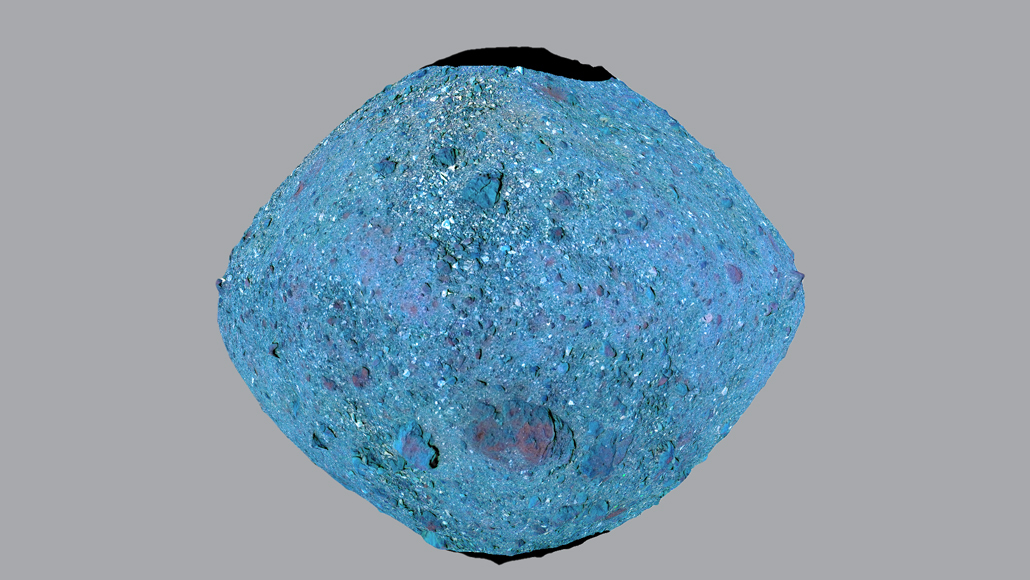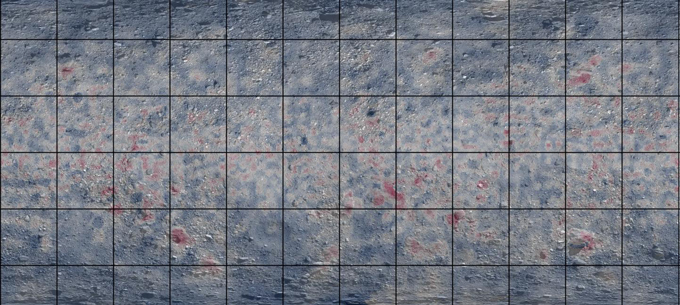The asteroid Bennu’s brittle boulders may make grabbing a sample easier
NASA’s OSIRIS-REx spacecraft is about to collect material from the space rock

Almost two years after NASA’s OSIRIS-REx arrived at asteroid Bennu, scientists have completely mapped the asteroid. This false-color image of Bennu’s rocky surface provides clues to how solid its boulders are.
Univ. of Arizona, Goddard/NASA
- More than 2 years ago
When NASA’s OSIRIS-REx arrived at near-Earth asteroid Bennu, scientists were dismayed to find a surface covered with hazardous-looking boulders.
But new research suggests that those boulders are surprisingly brittle. That’s potentially good news for the spacecraft, which is charged with grabbing a piece of Bennu on October 20 and returning it to Earth in 2023 (SN: 1/15/19). If the rocks are crumbly, that could lower the risk of damaging the spacecraft’s equipment.
That kind of rock also may be too fragile to survive the trip through Earth’s atmosphere without burning up. If so, scientists may be close to getting their hands on a never-before-seen kind of space rock, researchers report in a collection of papers published October 8 in Science and Science Advances.
Data taken from Earth before OSIRIS-REx launched suggested that Bennu’s surface would be sandy. So it was a shock to find a rough landscape strewn with boulders when the spacecraft arrived in 2018 (SN: 12/3/18).
“We had really convinced ourselves that Bennu was a smooth object,” says Daniella DellaGiustina, a planetary scientist at the University of Arizona in Tucson and member of the OSIRIS-REx team. “As everyone saw from the first pictures, that was not the case.”
The team found a relatively clear crater, nicknamed Nightingale, from which to retrieve a sample of the space rock (SN: 12/12/19). Still, the worry remains that the boulders might pose a safety hazard for the sampling system, which was designed to handle pebbles only a few centimeters across.
From late April through early June 2019, planetary scientist Ben Rozitis of the Open University in Milton Keynes, England, and colleagues mapped the way Bennu’s boulders retain heat, a clue to the rocks’ structure. Denser materials hold heat better than finer-grained ones, like how a sandy beach cools quickly after sundown, but single large rocks remain warm.

Based on those maps — and maps of other surface properties, described in the series of papers released October 8 — Bennu’s boulders seem to come in two flavors: darker-colored rocks that are weaker and more porous and lighter-colored, denser rocks that are stronger and less porous. Even the denser rocks are much more porous and brittle than meteorites from similar asteroids that have been found on Earth. The least dense meteorites are about 15 percent porous; Bennu’s rocks seem to be between 30 and 50 percent porous, Rozitis and colleagues found.
“This is exciting,” says DellaGiustina, a coauthor of the new papers. The spacecraft and its instruments might “encounter some boulders at the sample site that might otherwise be difficult to ingest,” she says, but “if they’re porous and weak, then they might just break down,” making them easier to collect.
The lighter, denser rocks also appear to be shot through with veins of carbonate, which suggests that they were in the presence of flowing water at some point in their past (SN: 12/10/18). NASA chose Bennu as an asteroid to visit partly because it resembles carbonaceous chondrite meteorites, which scientists think are time capsules of the early solar system. Similar space rocks could have delivered water and organic materials to Earth billions of years ago.
But Bennu’s more porous rocks appear to be unlike anything in scientists’ current assortment of meteorites, Rozitis says. “This is one of the cool things about OSIRIS-REx — it’s quite likely it will pick up new material that isn’t in our meteorite collection,” he says.
Sign up for our newsletter
We summarize the week's scientific breakthroughs every Thursday.
That’s believable, says meteor scientist Bill Cooke of NASA’s Marshall Space Flight Center in Huntsville, Ala. Observations of meteors have shown that low-density space rocks and dust burn up higher in Earth’s atmosphere than higher-density rocks.
“The old conventional wisdom was that the low-density stuff was from comets, and the high-density stuff was from asteroids,” he says. But recent observations show that some of the low-density rocks come from the orbits of asteroids. “So it is very plausible that low-density stuff from Bennu … would ablate higher in the atmosphere and not have a chance to create meteorites at all.”
If Bennu represents a missing piece in our understanding of the solar system’s history, studying that material in labs on Earth “will help us fill in an additional piece of the jigsaw,” Rozitis says.







